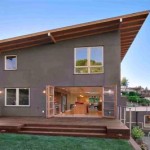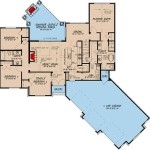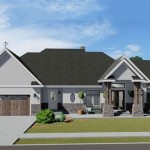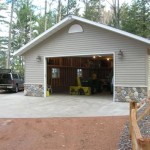House Plans With a Courtyard: An Exploration of Design and Functionality
House plans with a courtyard offer a unique blend of privacy, natural light, and architectural interest. These designs, which center around an open space enclosed by the structure of the house, have gained popularity for their versatility and ability to create a tranquil living environment. Courtyards can be adapted to a variety of architectural styles and lot sizes, making them a viable option for both urban and rural settings. This article delves into the key aspects of house plans with a courtyard, exploring the benefits, design considerations, and diverse applications of this architectural feature.
The Benefits of Courtyard House Plans
Courtyard house plans present several advantages over conventional home designs. One of the primary benefits is enhanced privacy. The courtyard acts as a buffer between the interior of the house and the outside world, shielding residents from street noise, prying eyes, and prevailing winds. This is particularly valuable in densely populated areas or on properties with limited natural screening.
Another significant advantage is the increased access to natural light and ventilation. By opening the interior spaces to the courtyard, natural light can penetrate deeper into the house, reducing the need for artificial lighting and creating a brighter, more inviting atmosphere. The courtyard also facilitates cross-ventilation, promoting airflow and reducing reliance on air conditioning, which can lead to energy savings and a healthier indoor environment.
Furthermore, courtyards provide a secure and controlled outdoor space. This is particularly appealing to families with young children or pets who can play safely within the enclosed area. The courtyard can also serve as an extension of the living space, providing an area for outdoor dining, relaxation, or gardening. It acts as a seamless transition between the interior and exterior, enhancing the overall living experience.
The design aesthetic is another crucial benefit. A courtyard introduces a focal point to the house, offering opportunities for landscaping, water features, or architectural accents. The courtyard becomes an integral part of the home's aesthetic, adding visual interest and enhancing the overall curb appeal. The versatility of the design allows for personal expression, adapting to various tastes and preferences.
Design Considerations for Courtyard House Plans
Designing a house plan with a courtyard requires careful consideration of several factors. The size and shape of the courtyard are paramount. The proportions should be balanced with the overall size of the house and the intended use of the space. A small courtyard may feel cramped, while an excessively large courtyard might lack intimacy and be difficult to maintain. The shape of the courtyard also influences its functionality and aesthetic appeal. Rectangular, square, or L-shaped courtyards are common, but custom shapes can be designed to suit specific site conditions and design preferences.
Orientation is a critical factor influencing the amount of sunlight and shade the courtyard receives. Courtyards facing south or east tend to receive more sunlight, which can be beneficial in cooler climates. Conversely, courtyards facing north or west receive less direct sunlight, which can be advantageous in warmer climates. The orientation should be carefully considered to optimize thermal comfort and minimize the need for artificial heating and cooling.
Material selection plays a crucial role in the overall aesthetic and functionality of the courtyard. Paving materials should be durable, slip-resistant, and aesthetically pleasing. Natural stone, brick, concrete pavers, and decking are common choices. The choice of materials for the surrounding walls and features should complement the overall architectural style of the house. Planting materials should be selected based on the climate, soil conditions, and the desired aesthetic. Drought-tolerant plants are often a good choice for courtyards in arid regions.
Drainage is an essential consideration to prevent water from accumulating in the courtyard. Adequate drainage systems should be installed to ensure that rainwater is effectively channeled away from the house. This is particularly important in areas with heavy rainfall. Proper grading and the use of permeable paving materials can help to improve drainage and prevent flooding.
Privacy is another important factor to consider, especially in urban settings. The height of the surrounding walls and the placement of windows and doors should be carefully planned to ensure adequate privacy for the residents. Landscaping can also be used to enhance privacy, providing a natural screen from neighboring properties.
Diverse Applications of Courtyard House Plans
Courtyard house plans can be adapted to a wide range of architectural styles and site conditions. Traditional courtyard houses, such as those found in Mediterranean and Middle Eastern architecture, often feature enclosed courtyards with fountains, gardens, and intricate tile work. These designs emphasize privacy, shade, and a connection to nature. Modern courtyard house plans often incorporate clean lines, minimalist design, and open floor plans. These designs may feature larger courtyards with outdoor living areas, swimming pools, and sculptural elements.
Courtyard houses are particularly well-suited for challenging sites, such as narrow lots or properties with irregular shapes. The courtyard can be used to create a sense of spaciousness and privacy in otherwise cramped conditions. The courtyard can also be used to address specific site challenges, such as steep slopes or poor soil conditions.
Adaptive reuse projects often incorporate courtyard house plans to transform existing buildings into contemporary living spaces. Courtyards can be created by removing sections of the existing roof or walls, creating a new focal point and bringing natural light into the renovated structure. This approach can be particularly effective in revitalizing historic buildings and creating unique and sustainable living environments.
In educational settings, courtyard designs are often employed to create secure and engaging outdoor learning spaces. School buildings can be designed with interior courtyards that serve as gathering areas for students, outdoor classrooms, and spaces for relaxation and recreation. These courtyards can provide a safe and stimulating environment for learning and social interaction.
Commercial applications also benefit from courtyard design principles. Office buildings can incorporate courtyards to provide employees with a pleasant and relaxing outdoor space. Restaurants can use courtyards to create attractive outdoor dining areas. Retail spaces can use courtyards to enhance the shopping experience and create a more inviting atmosphere.
The use of courtyards can extend to multi-family dwellings as well. Apartment complexes and townhouses can be designed with individual or shared courtyards, creating a sense of community and providing residents with private outdoor spaces. These courtyards can enhance the quality of life for residents and increase the overall appeal of the development.
Accessibility is a vital consideration in courtyard design. Ensure that the courtyard and its access points are designed to be usable by individuals with mobility impairments. Ramps, level thresholds, and wide pathways should be integrated into the design to promote inclusivity and accessibility.
The integration of technology can further enhance the functionality of a courtyard. Smart lighting, automated irrigation systems, and outdoor audio-visual equipment can be incorporated to create a more comfortable and convenient outdoor living space. This can make the courtyard usable throughout the year and enhance its appeal.
Finally, the long-term maintenance of the courtyard should be considered. Selecting durable and low-maintenance materials, installing efficient irrigation systems, and implementing a regular cleaning schedule can help to ensure that the courtyard remains a beautiful and functional space for years to come. This is crucial for retaining the property's value and the residents' enjoyment.

Radical Terrace Pool House Plans Courtyard U Shaped

Grama Sue S Floor Plan Play Land Olivia Courtyard Container House Plans Small

House Plans With Courtyards And Open Atriums

Courtyard House Abin Design Studio Archdaily

Floor Plans With Courtyard Google Search House Model Plan

Courtyard House Plans 61custom Contemporary Modern

Design For A Square Courtyard House Ground Floor Plan Riba Pix

Home Plan Casoria Tuscan House Plans Design Sater Collection

Home Plans With A Central Courtyard Full In Law Apartment

House Plans With Courtyards And Open Atriums








